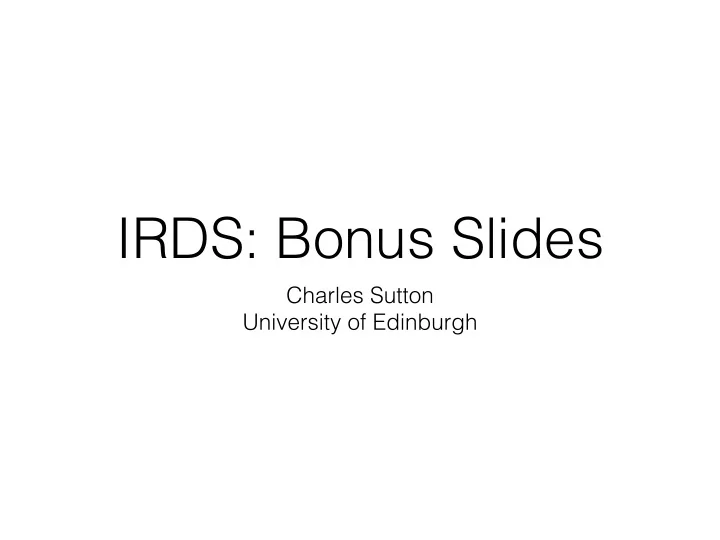

IRDS: Bonus Slides Charles Sutton University of Edinburgh
Hello there I will not present these slides in class. Next lecture we will discuss how to choose features for learning algorithms. This means you need to understand a bit about learning algorithms. There are just an outline of topics that will help you to appreciate the next lecture. These slides: • List a few representative algorithms • What you should know about them • With links to readings to learn about them To be ready for the next lecture, what you really need: • to know how the classifiers represent the decision boundary • not the algorithm for how the classifier is learnt • (good to know, but not necessary for next lecture)
List of Algorithms (with readings) Here are the ones we will “discuss” • Linear regression • Fitting nonlinear functions by adding basis functions • BRML Sec 17.1, 17.2 • Logistic regression • BRML Sec 17.4 • (just first few pages, don’t worry about training algorithms) • k-nearest neighbour • BRML Sec 14.1, 14.2 • Decision trees • HTF Sec 9.2 Why these? • practical • have different types of decision boundaries • so representative for purposes of next lecture
Key to previous slide • BRML : Barber. Bayesian Reasoning and Machine Learning. CUP, 2012. http://web4.cs.ucl.ac.uk/staff/D.Barber/pmwiki/ pmwiki.php?n=Brml.HomePage • HTF : Hastie, Tibshirani, and Friedman. The Elements of Statistical Learning 2nd ed, Springer, 2009. http:// statweb.stanford.edu/~tibs/ElemStatLearn/
Linear regression x ∈ R d denote the feature vector. Trying to predict y ∈ R Let w ∈ R d Simplest choice a linear function. Define parameters d X y = f ( x , w ) = w > x = ˆ w j x j j =1 (to keep notation simple assume that always ) x d = 1 2.5 Given a data set x (1) . . . x ( N ) , y (1) , . . . , y ( N ) 2 find the best parameters 1.5 N y ( i ) − w > x ( i ) ⌘ 2 ⇣ X 1 min w i =1 0.5 which can be solved easily 0 − 2 − 1 0 1 2 3 (but I won’t say how)
Nonlinear regression What if we want to learn a nonlinear function? Trick: Define new features, e.g., for scalar x, define φ ( x ) = (1 , x, x 2 ) > y = f ( x , w ) = w > φ ( x ) ˆ this is still linear in w degree 2 To find parameters, 15 the minimisation problem is now 10 N ⌘ 2 ⇣ X y ( i ) − w > φ ( x ( i ) ) 5 min w i =1 0 − 5 exactly the same form as before (because x is fixed) − 10 0 5 10 15 20 so still just as easy
Logistic regression (a classification method, despite the name) x 2 Linear regression was easy. o o o o Can we do linear classification too? o o o w o o x o o x x Define a discriminant function x x 1 f ( x , w ) = w > x x x x x Then predict using ( 1 if f ( x , w ) ≥ 0 y = 0 otherwise yields linear decision boundary Can get class probabilities from this idea, using logistic regression: 1 p ( y = 1 | x ) = 1 + exp { − w > x } (to show decision boundaries same, compute log odds log p ( y = 1 | x ) p ( y = 0 | x )
K-Nearest Neighbour simple method for classification or regression Define a distance function between feature vectors D ( x , x 0 ) To classify a new feature vector x N K ( x ) 1. Look through your training set. Find the K closest points. Call them (this is memory-based learning.) 2. Return the majority vote. 3. If you want a probability, take the proportion p ( y = c | x ) = 1 I { y 0 = c } X K ( y 0 , x 0 ) 2 N K ( x ) (the running time of this algorithm is terrible. See IAML for better indexing.)
K-Nearest Neighbour data train 5 Decision boundaries can be highly nonlinear 4 3 The bigger the K, the smoother the boundary 2 This is nonparametric : the complexity 1 of the boundary varies depending on 0 the amount of training data − 1 − 2 − 3 − 2 − 1 0 1 2 3 predicted label, K=1 predicted label, K=5 5 5 4 4 3 3 k=1 k=5 2 2 1 1 0 0 − 1 c1 − 1 c1 c2 c2 c3 c3 − 2 − 2 − 3 − 2 − 1 0 1 2 3 − 3 − 2 − 1 0 1 2 3
Decision Trees R 5 R 2 t 4 X 1 ≤ t 1 X 2 R 3 t 2 R 4 X 2 ≤ t 2 X 1 ≤ t 3 R 1 R 1 R 2 R 3 X 2 ≤ t 4 t 1 t 3 X 1 R 4 R 5 Can be used for classification or regression Can handle discrete or continuous features Interpretable but tend not to work as well as other methods. X 2 X 1 (figure from Hastie, Tibshirani, and Friedman, 2009)
Recommend
More recommend